MITSUBISHI iMiEV 2016 1.G Owners Manual
Manufacturer: MITSUBISHI, Model Year: 2016, Model line: iMiEV, Model: MITSUBISHI iMiEV 2016 1.GPages: 296, PDF Size: 7.79 MB
Page 271 of 296
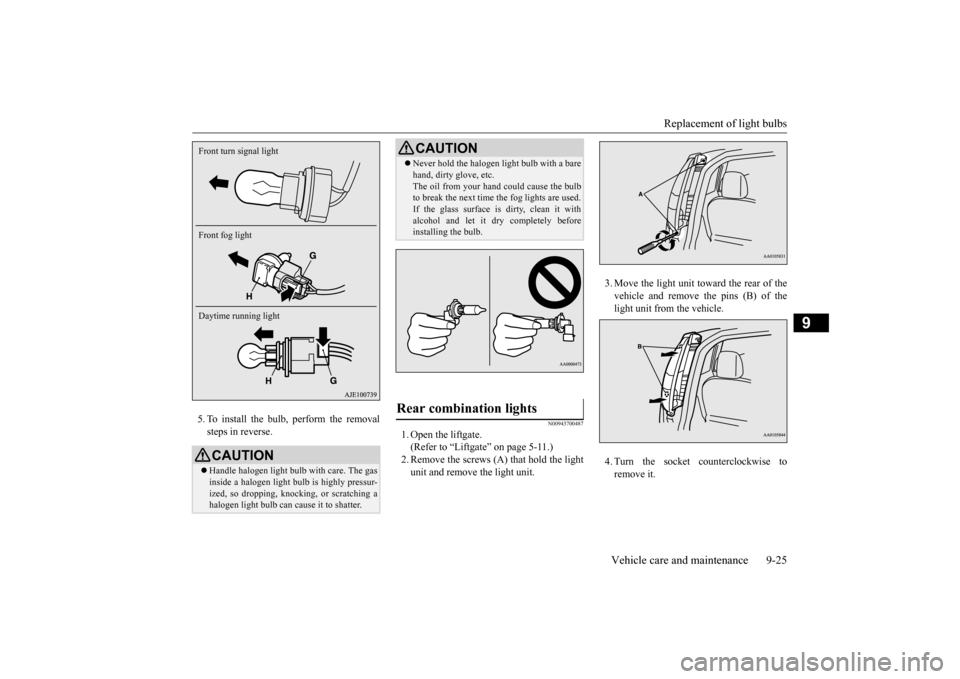
Replacement of light bulbs
Vehicle care and maintenance 9-25
9
5. To install the bulb, perform the removal steps in reverse.
N00943700487
1. Open the liftgate.(Refer to
Page 272 of 296
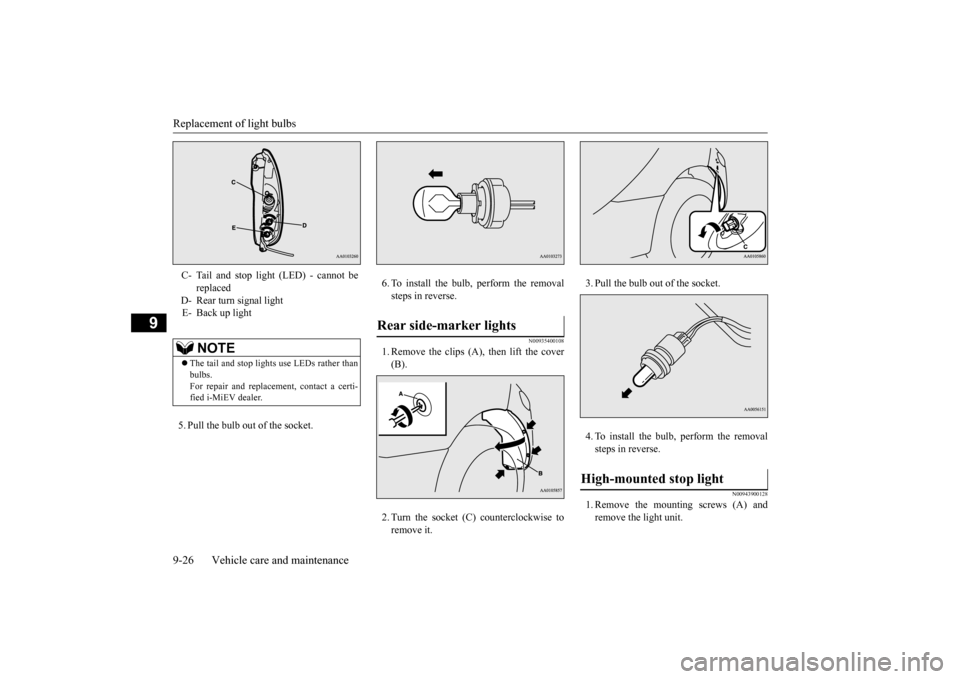
Replacement of light bulbs 9-26 Vehicle care and maintenance
9
5. Pull the bulb out of the socket.
6. To install the bulb, perform the removal steps in reverse.
N00935400108
1. Remove the clips (A), then lift the cover(B). 2. Turn the socket (C) counterclockwise to remove it.
3. Pull the bulb out of the socket. 4. To install the bulb, perform the removal steps in reverse.
N00943900128
1. Remove the mounti
ng screws (A) and
remove the light unit.
C- Tail and stop light (LED) - cannot be
replaced
D- Rear turn signal light E- Back up light
NOTE
The tail and stop lights use LEDs rather than bulbs. For repair and replacement, contact a certi- fied i-MiEV dealer.
Rear side-marker lights
High-mounted stop light
BK0220401US.book 26 ページ 2015年6月3日 水曜日 午前7時42分
Page 273 of 296
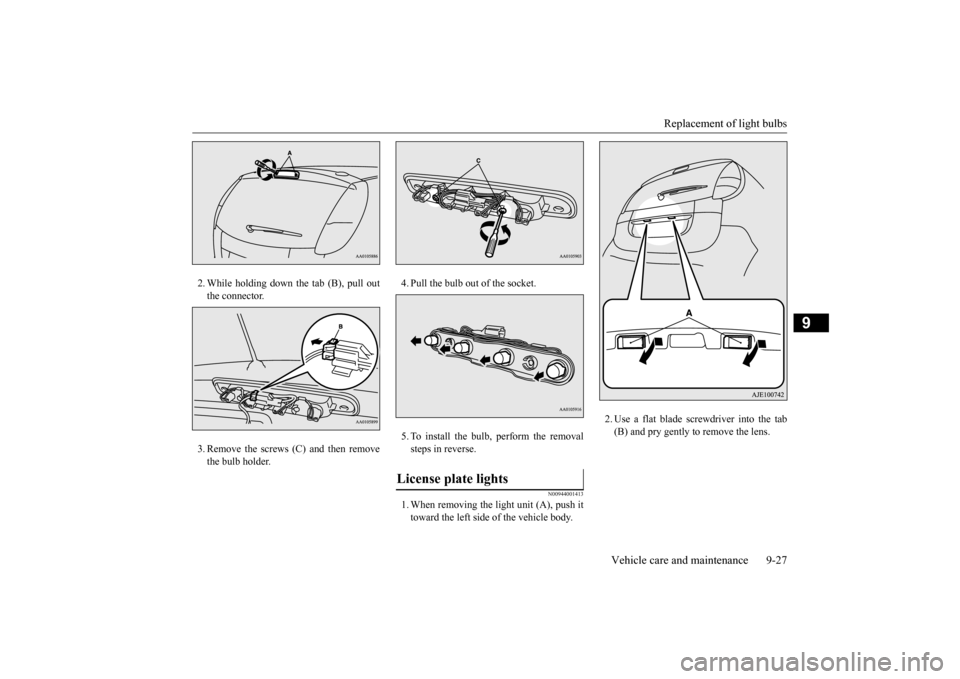
Replacement of light bulbs
Vehicle care and maintenance 9-27
9
2. While holding down the tab (B), pull out the connector. 3. Remove the screws (C) and then remove the bulb holder.
4. Pull the bulb out of the socket. 5. To install the bulb, perform the removal steps in reverse.
N00944001413
1. When removing the li
ght unit (A), push it
toward the left side of the vehicle body.
2. Use a flat blade screwdriver into the tab (B) and pry gently to remove the lens.
License plate lights
BK0220401US.book 27 ページ 2015年6月3日 水曜日 午前7時42分
Page 274 of 296
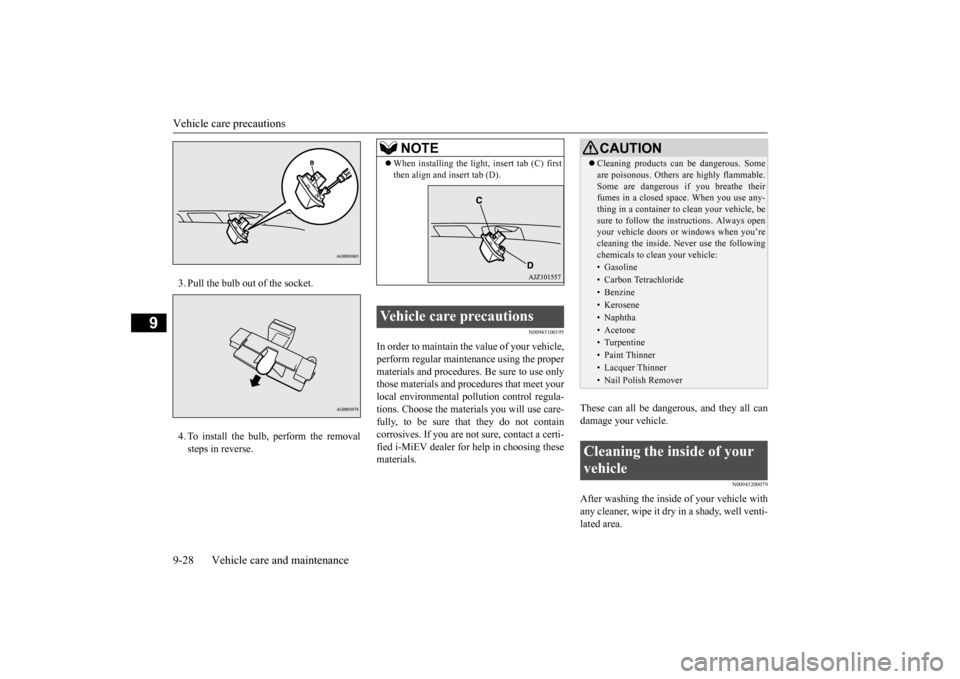
Vehicle care precautions 9-28 Vehicle care and maintenance
9
3. Pull the bulb out of the socket. 4. To install the bulb, perform the removal steps in reverse.
N00945100195
In order to maintain the value of your vehicle, perform regular mainte
nance using the proper
materials and procedures. Be sure to use onlythose materials and proc
edures that meet your
local environmental pollution control regula- tions. Choose the materials you will use care-fully, to be sure that they do not contain corrosives. If you are not sure, contact a certi- fied i-MiEV dealer for
help in choosing these
materials.
These can all be dangerous, and they all can damage your vehicle.
N00945200079
After washing the inside of your vehicle withany cleaner, wipe it dry in a shady, well venti- lated area.
NOTE
When installing the light, insert tab (C) first then align and insert tab (D).
Vehicle care precautions
CAUTION Cleaning products can be dangerous. Some are poisonous. Others are highly flammable.Some are dangerous if you breathe theirfumes in a closed space. When you use any- thing in a container to
clean your vehicle, be
sure to follow the instructions. Always openyour vehicle doors or windows when you’re cleaning the inside. Never use the following chemicals to clean your vehicle:• Gasoline• Carbon Tetrachloride• Benzine• Kerosene• Naphtha• Acetone• Turpentine• Paint Thinner• Lacquer Thinner• Nail Polish Remover
Cleaning the inside of your vehicle
BK0220401US.book 28 ページ 2015年6月3日 水曜日 午前7時42分
Page 275 of 296
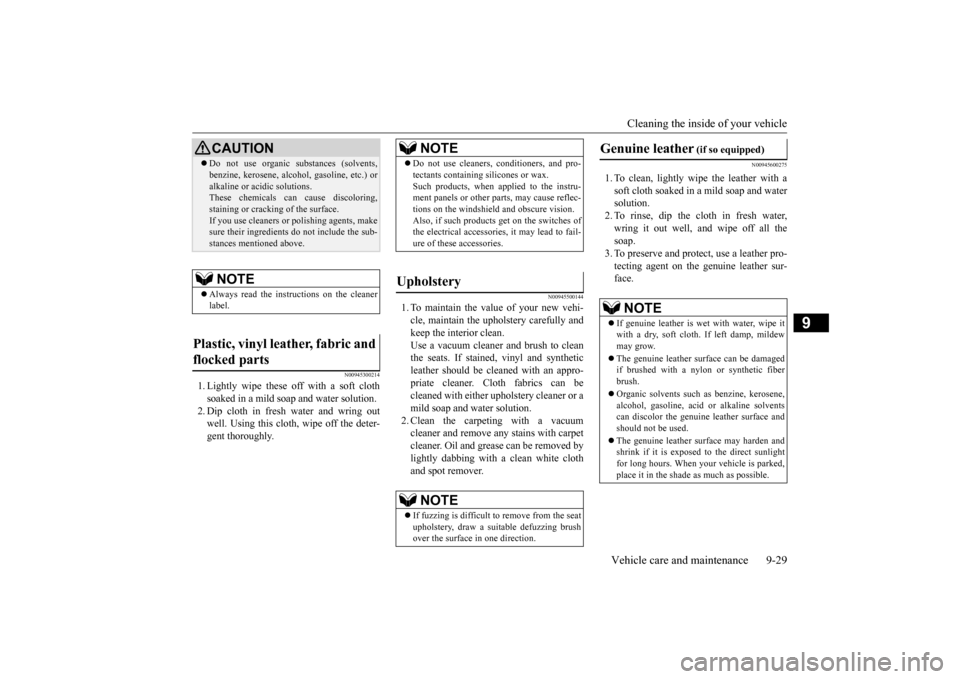
Cleaning the inside of your vehicle
Vehicle care and maintenance 9-29
9
N00945300214
1. Lightly wipe these off with a soft cloth soaked in a mild soap and water solution. 2. Dip cloth in fresh water and wring out well. Using this cloth,
wipe off the deter-
gent thoroughly.
N00945500144
1. To maintain the value of your new vehi-cle, maintain the upholstery carefully andkeep the interior clean. Use a vacuum cleaner
and brush to clean
the seats. If stained,
vinyl and synthetic
leather should be cleaned with an appro- priate cleaner. Cloth fabrics can be cleaned with either upholstery cleaner or amild soap and water solution. 2. Clean the carpeting with a vacuum cleaner and remove any stains with carpetcleaner. Oil and grea
se can be removed by
lightly dabbing with
a clean white cloth
and spot remover.
N00945600275
1. To clean, lightly wi
pe the leather with a
soft cloth soaked in a mild soap and water solution.2. To rinse, dip the cloth in fresh water, wring it out well, and wipe off all the soap. 3. To preserve and prot
ect, use a leather pro-
tecting agent on the genuine leather sur- face.
CAUTION Do not use organic s
ubstances (solvents,
benzine, kerosene, alc
ohol, gasoline, etc.) or
alkaline or acidic solutions.These chemicals can
cause discoloring,
staining or cracking of the surface. If you use cleaners or polishing agents, makesure their ingredients do not include the sub- stances mentioned above.NOTE
Always read the instru
ctions on the cleaner
label.
Plastic, vinyl leat
her, fabric and
flocked parts
NOTE
Do not use cleaners,
conditioners, and pro-
tectants containi
ng silicones or wax.
Such products, when applied to the instru-ment panels or other pa
rts, may cause reflec-
tions on the windshiel
d and obscure vision.
Also, if such products
get on the switches of
the electrical accessories, it may lead to fail- ure of these accessories.
Upholstery
NOTE
If fuzzing is difficult to remove from the seat upholstery, draw a suit
able defuzzing brush
over the surface in one direction.
Genuine leather
(if so equipped)
NOTE
If genuine leather is we
t with water, wipe it
with a dry, soft cloth. If left damp, mildew may grow. The genuine leather su
rface can be damaged
if brushed with a nylon or synthetic fiber brush. Organic solvents such as benzine, kerosene, alcohol, gasoline, acid
or alkaline solvents
can discolor the genuine
leather surface and
should not be used. The genuine leather su
rface may harden and
shrink if it is exposed to the direct sunlight for long hours. When your vehicle is parked,place it in the shade as much as possible.
BK0220401US.book 29 ページ 2015年6月3日 水曜日 午前7時42分
Page 276 of 296
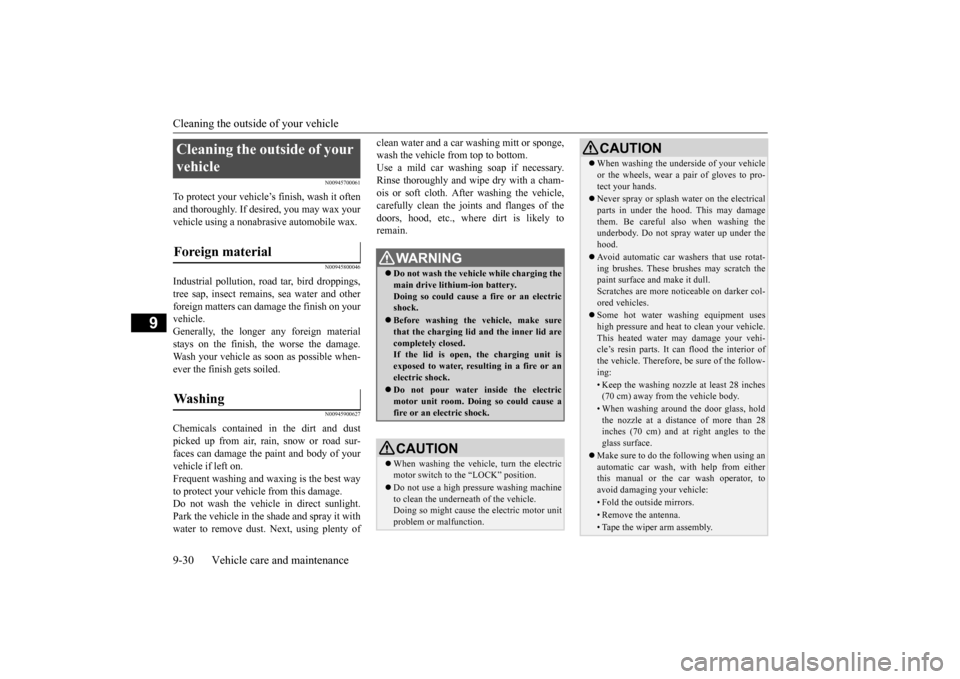
Cleaning the outside of your vehicle 9-30 Vehicle care and maintenance
9
N00945700061
To protect your vehicle’s finish, wash it often and thoroughly. If desired, you may wax your vehicle using a nonabras
ive automobile wax.
N00945800046
Industrial pollution, road tar, bird droppings, tree sap, insect remain
s, sea water and other
foreign matters can damage the finish on your vehicle.Generally, the longer any foreign material stays on the finish, the worse the damage. Wash your vehicle as soon as possible when-ever the finish gets soiled.
N00945900627
Chemicals cont
ained in the dirt and dust
picked up from air, rain, snow or road sur- faces can damage the paint and body of your vehicle if left on.Frequent washing and wa
xing is the best way
to protect your vehicl
e from this damage.
Do not wash the vehicle in direct sunlight.Park the vehicle in the shade and spray it with water to remove dust.
Next, using plenty of
clean water and a car washing mitt or sponge, wash the vehicle from top to bottom.Use a mild car washing soap if necessary. Rinse thoroughly and wipe
dry with a cham-
ois or soft cloth. Af
ter washing the vehicle,
carefully clean the join
ts and flanges of the
doors, hood, etc., wher
e dirt is likely to
remain.
Cleaning the outside of your vehicle Foreign material Wa s h i n g
WA R N I N G Do not wash the vehicle while charging the main drive lithium-ion battery. Doing so could cause a fire or an electric shock. Before washing the vehicle, make sure that the charging lid and the inner lid arecompletely closed. If the lid is open, the charging unit is exposed to water, resulting in a fire or anelectric shock. Do not pour water inside the electric motor unit room. Doing so could cause a fire or an el
ectric shock.
CAUTIONWhen washing the vehicle, turn the electric motor switch to the “LOCK” position. Do not use a high pressure washing machine to clean the underneath of the vehicle. Doing so might cause th
e electric motor unit
problem or malfunction.
When washing the underside of your vehicle or the wheels, wear a pair of gloves to pro-tect your hands. Never spray or splash
water on the electrical
parts in under the hood. This may damagethem. Be careful also when washing the underbody. Do not spray water up under the hood. Avoid automatic car washers that use rotat- ing brushes. These br
ushes may scratch the
paint surface and make it dull. Scratches are more not
iceable on darker col-
ored vehicles. Some hot water wash
ing equipment uses
high pressure and heat
to clean your vehicle.
This heated water ma
y damage your vehi-
cle’s resin parts. It
can flood the interior of
the vehicle. Therefore,
be sure of the follow-
ing:• Keep the washing nozzle at least 28 inches(70 cm) away from the vehicle body.• When washing around the door glass, holdthe nozzle at a distance of more than 28 inches (70 cm) and at right angles to the glass surface.
Make sure to do the following when using an automatic car wash, with help from eitherthis manual or the car wash operator, to avoid damaging your vehicle:• Fold the outside mirrors.• Remove the antenna.• Tape the wiper arm assembly.CAUTION
BK0220401US.book 30 ページ 2015年6月3日 水曜日 午前7時42分
Page 277 of 296
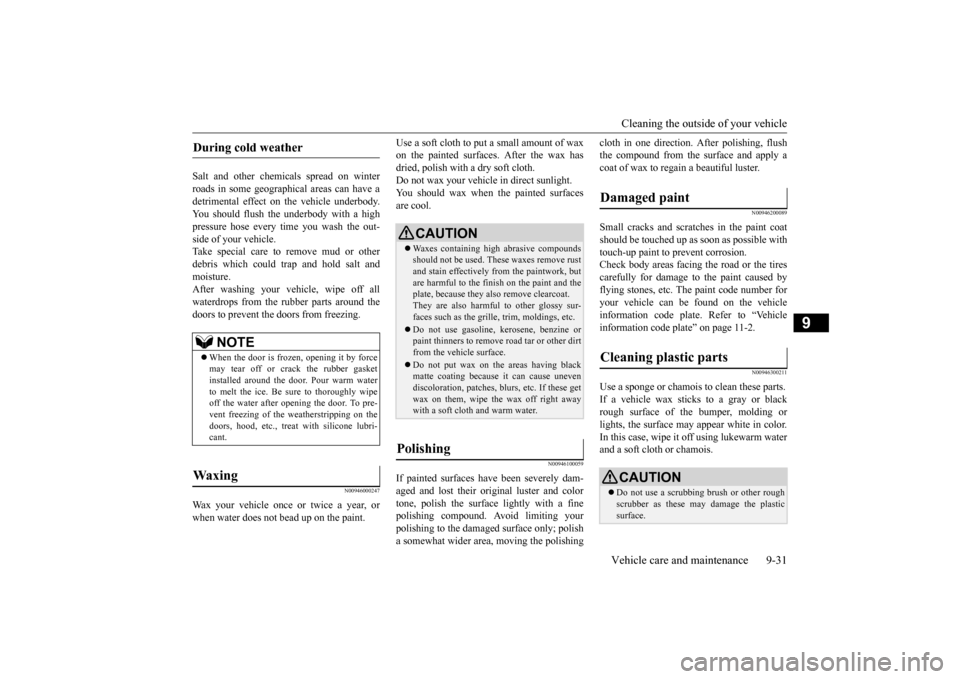
Cleaning the outside of your vehicle Vehicle care and maintenance 9-31
9
Salt and other chemical
s spread on winter
roads in some geographical areas can have a detrimental effect on the vehicle underbody.You should flush the underbody with a high pressure hose every time you wash the out- side of your vehicle.Take special care to remove mud or other debris which could trap and hold salt and moisture. After washing your vehicle, wipe off all waterdrops from the rubber parts around thedoors to prevent the doors from freezing.
N00946000247
Wax your vehicle once or twice a year, orwhen water does not
bead up on the paint.
Use a soft cloth to put a small amount of wax on the painted surfaces.
After the wax has
dried, polish with
a dry soft cloth.
Do not wax your vehicle in direct sunlight. You should wax when the painted surfacesare cool.
N00946100059
If painted surfaces have
been severely dam-
aged and lost their original luster and color tone, polish the surface
lightly with a fine
polishing compound. Avoid limiting your polishing to the damage
d surface only; polish
a somewhat wider area, moving the polishing
cloth in one direction.
After polishing, flush
the compound from the surface and apply acoat of wax to regain a beautiful luster.
N00946200089
Small cracks and scratches in the paint coatshould be touched up as
soon as possible with
touch-up paint to prevent corrosion. Check body areas facing the road or the tires carefully for damage to the paint caused by flying stones, etc. The
paint code number for
your vehicle can be found on the vehicle information code plate. Refer to “Vehicle information code pl
ate” on page 11-2.
N00946300211
Use a sponge or chamois to clean these parts. If a vehicle wax sticks
to a gray or black
rough surface of the bumper, molding or lights, the surface may appear white in color. In this case, wipe it
off using lukewarm water
and a soft cloth or chamois.
During cold weather
NOTE
When the door is frozen, opening it by force may tear off or cr
ack the rubber gasket
installed around the door. Pour warm water to melt the ice. Be
sure to thoroughly wipe
off the water after opening the door. To pre- vent freezing of the
weatherstripping on the
doors, hood, etc., treat
with silicone lubri-
cant.
Waxing
CAUTION Waxes containing high abrasive compounds should not be used. These waxes remove rustand stain effectively fr
om the paintwork, but
are harmful to the finish on the paint and the plate, because they also remove clearcoat.They are also harmful to other glossy sur- faces such as the grille, trim, moldings, etc. Do not use gasoline, kerosene, benzine or paint thinners to remove
road tar or other dirt
from the vehicle surface. Do not put wax on the areas having black matte coating because
it can cause uneven
discoloration, patches, bl
urs, etc. If these get
wax on them, wipe the wax off right away with a soft clot
h and warm water.
Polishing
Damaged paint Cleaning plastic parts
CAUTION Do not use a scrubbing brush or other rough scrubber as these may
damage the plastic
surface.
BK0220401US.book 31 ページ 2015年6月3日 水曜日 午前7時42分
Page 278 of 296

Cleaning the outside of your vehicle 9-32 Vehicle care and maintenance
9
N00946400065
To prevent spots and corrosion of chrome parts, wash with water, dry thoroughly, andapply a nonabrasive automotive wax. If the chrome is severely da
maged or pitted, use a
commercially available chrome polish.
N00946500196
1. Remove dirt using a wet sponge.2. Use a mild detergent on any dirt that can-not be removed ea
sily with water.
Rinse off the detergent after washing the wheel.3. Dry the wheel thoroughly using a chamois leather or a soft cloth.
N00946600067
The window glass can
usually be cleaned
using only a sponge and
water. Glass cleaner
can be used to remove wax, oil, grease, deadinsects, etc. After washing the glass, wipe it dry with a clean, dry, soft cloth.
N00946700097
Use a soft cloth and gl
ass cleaner to remove
grease, dead insects, etc., from the wiper blades.Replace the wiper blades when they no longer clean the windshield and rear window prop- erly.
N00947000127
Never spray or splash
water on the electrical
components under the hood, as this may cause damage.Do not allow any nearby
parts (such as plastic
parts) come into contact with sulphuric acid (12V starter battery el
ectrolyte), which may
crack, stain, or discolour them. If this occurs, wipe the parts with a soft cloth saturated with a mild detergent and water solution. Then immediately rinse the affected partswith plenty of water.
Do not use wax containing compounds (pol- ishing powder) which ma
y damage the plas-
tic surface. Do not let the plastic parts get soiled with gasoline, oil, brake fl
uids, greases, paint
thinner, and sulfuric
acid (battery electro-
lyte). These fluids, et
c., may crack, stain or
discolor the plastic parts.If any of these get on the plastic parts, wipe them up with a soft cloth or chamois and a mild solution of soap and water. Then rinsethem immediately with water.
Chrome parts Aluminum wheels
CAUTION
CAUTION Do not use a brush or other hard implement on the wheels.Doing so could scratch the wheels. Do not use any cleaner that contains an abra- sive substance or is ac
idic or alkaline. Doing
so could cause the co
ating on the wheels to
peel or become disc
olored or stained.
Do not directly apply
hot water using a steam
cleaner or by any other means. Contact with seawater or road salt used for de-icing can cause corr
osion. Rinse off such
substances as soon as possible.
Window glass Wiper blades
Under the hood
BK0220401US.book 32 ページ 2015年6月3日 水曜日 午前7時42分
Page 279 of 296
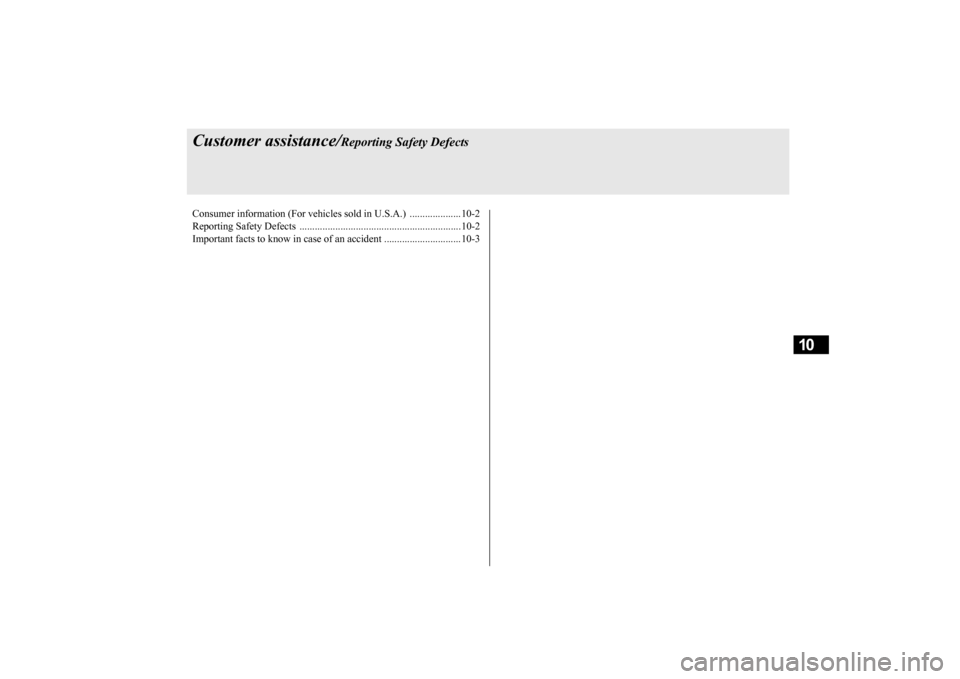
10
Customer assistance/
Reporting Safety Defects
Consumer information (For vehicles sold in U.S.A.) ....................10-2 Reporting Safety Defects ...............................................................10-2 Important facts to know in
case of an accident ....
..............
............10-3
BK0220401US.book 1 ページ 2015年6月3日 水曜日 午前7時42分
Page 280 of 296
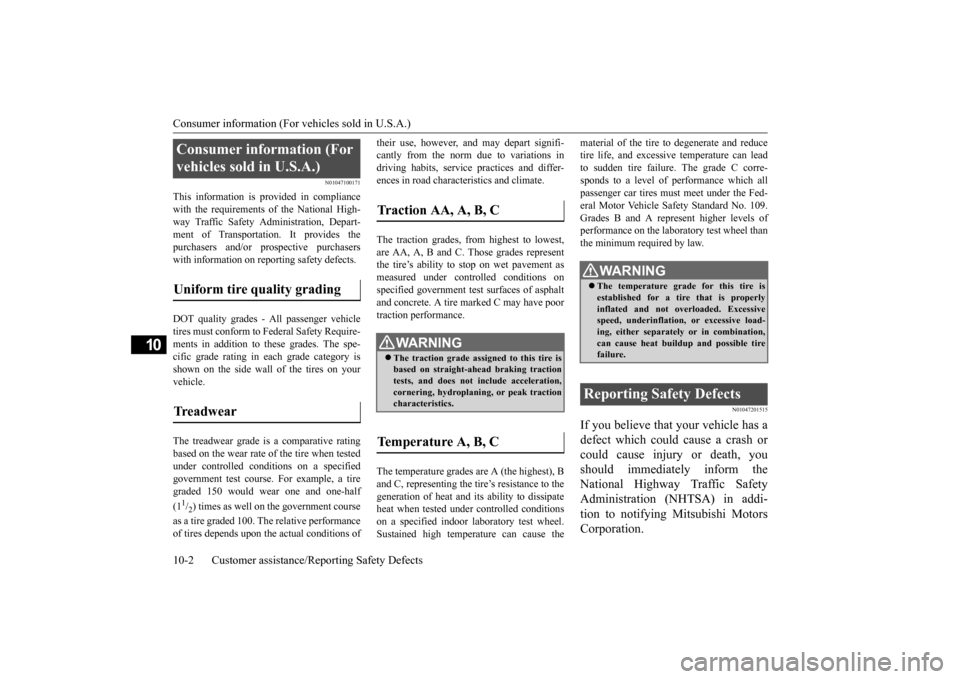
Consumer information (For vehicles sold in U.S.A.) 10-2 Customer assistance/Re
porting Safety Defects
10
N01047100171
This information is provided in compliance with the requirements of the National High- way Traffic Safety Ad
ministration, Depart-
ment of Transportation. It provides the purchasers and/or prospective purchasers with information on repor
ting safety defects.
DOT quality grades - Al
l passenger vehicle
tires must conform to
Federal Safety Require-
ments in addition to these grades. The spe- cific grade rating in each grade category isshown on the side wall of the tires on your vehicle. The treadwear grade is a comparative rating based on the wear rate of
the tire when tested
under controlled conditions on a specifiedgovernment test course
. For example, a tire
graded 150 would wear one and one-half (11/2) times as well on the government course
as a tire graded 100.
The relative performance
of tires depends upon the actual conditions of
their use, however, and may depart signifi- cantly from the norm due to variations indriving habits, service practices and differ- ences in road characteristics and climate. The traction grades, from highest to lowest, are AA, A, B and C. Those grades represent the tire’s ability to
stop on wet pavement as
measured under controlled conditions on specified government te
st surfaces of asphalt
and concrete. A tire marked C may have poor traction performance. The temperature grades are A (the highest), B and C, representing the ti
re’s resistance to the
generation of heat and it
s ability to dissipate
heat when tested un
der controlled conditions
on a specified indoor
laboratory test wheel.
Sustained high temperature can cause the
material of the tire to
degenerate and reduce
tire life, and excessive temperature can leadto sudden tire failure. The grade C corre- sponds to a level of performance which all passenger car tires must meet under the Fed-eral Motor Vehicle Safety Standard No. 109. Grades B and A represent higher levels of performance on the labora
tory test wheel than
the minimum required by law.
N01047201515
If you believe that your vehicle has a defect which could cause a crash or could cause injury or death, you should immediately inform theNational Highway Traffic Safety Administration (NHTSA) in addi- tion to notifying Mitsubishi MotorsCorporation.
Consumer information (For vehicles sold in U.S.A.) Uniform tire quality grading Treadwear
Traction AA, A, B, C
WA R N I N G The traction grade assi
gned to this tire is
based on straight-ahead braking tractiontests, and does not include acceleration, cornering, hydroplani
ng, or peak traction
characteristics.
Temperature A, B, C
WA R N I N G The temperature grade for this tire is established for a tire that is properlyinflated and not overloaded. Excessive speed, underinflation
, or excessive load-
ing, either separately
or in combination,
can cause heat buildup and possible tire failure.
Reporting Safety Defects
BK0220401US.book 2 ページ 2015年6月3日 水曜日 午前7時42分